About a hundred different species of tulip exist, ten of them can be found in Greece and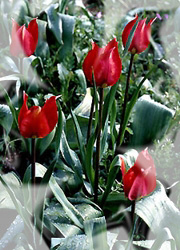 some of them grow only in our country. Four species of tulip can be found in Chios and are called lalades. Tulipa praecox, Tulipa aegenensis, Tulipa clusiana, and Tulipa undulatifolia. some of them grow only in our country. Four species of tulip can be found in Chios and are called lalades. Tulipa praecox, Tulipa aegenensis, Tulipa clusiana, and Tulipa undulatifolia.
Tulips originate from central Asia. Tien San and the mountains of Pamir Ale in Islamabad is one of the two first regions with tulips. The second region is Azerbaijan and Armenia. And later the growth of tulips expanded to all the Mediterranean.
The botanist Carolus Clusius brought tulips to Holand in 1593 when he became responsible for the botanic garden in University of Leiden and studied possible medical applications of tulips.
Tulip is reported in a lot of Greek and Persian fables. Fables that mold the history of tulip. 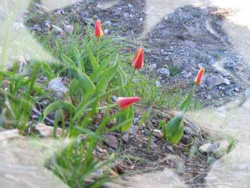 According to one of them: Once upon a time there was a Persian prince who was named Farah. Farah was very in love with the Schirin. When his beloved one was killed, Farah fell with his horse and died. Each drop of his blood on the ground became a tulip. The tulips are considered symbol of true love. According to one of them: Once upon a time there was a Persian prince who was named Farah. Farah was very in love with the Schirin. When his beloved one was killed, Farah fell with his horse and died. Each drop of his blood on the ground became a tulip. The tulips are considered symbol of true love.
The Greeks but also the Ottomen loved very the tulips. In the period of Byzantium it is known that tulips were cultivated in the Asia Minor. The vizier Lalizaris had in his gardens more than 500.000 tulips. 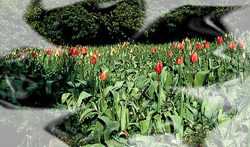 Tulip was also used as pattern in the decoration of Bible's first letters on 12th century. Tulip was also used as pattern in the decoration of Bible's first letters on 12th century.
It is unknown where did the name tulip come from. A possible explanation is that it comes from toliban, that is the head cover that people wore in Middle East, and it resembles a tulip.
In Chios we meet lalades (the local name for tulips) mainly in central and south-eastern region of the island. From March they begin to submerge the cultivated regions, the olive groves, the almond groves, and the fields of island as well. 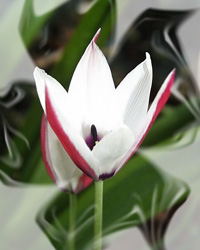 The time of their blossoming depends from the weather. Each plant maintains the flowers for 7 to 10 days. Even though as plant "it steals" water and nutritious components from cultivated goods, the farmers admir their beauty and do not try hard to get rid of the tulips. The time of their blossoming depends from the weather. Each plant maintains the flowers for 7 to 10 days. Even though as plant "it steals" water and nutritious components from cultivated goods, the farmers admir their beauty and do not try hard to get rid of the tulips.
Let's meet the tulips - lalades of Chios, one by one.
Tulipa Praecox Ten or Toyrkolalas. Flowers have bright red colour. The bulb has tunics with woolly hairs (the internal side is covered by a thick layer that ensures greater protection from the cold). Its height reaches 70 cm. It is also met near cultivated regions, fields and olive groves.
Tulipa agenensis DC in Redoute or fragkolalas, its height reaches 50 cm. Flowers are red 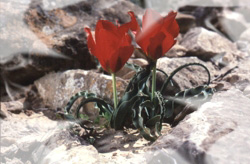 and in their inside have black stains and yellow striations. This is also found near cultivated regions, fields and olive groves and in their inside have black stains and yellow striations. This is also found near cultivated regions, fields and olive groves
Tulipa clusiana DC in Redoute or laladaki politiko or vavilousiko. This is a variety of small lalades, up to 60 cm height, with white flowers with intense exterior striations of purple colour. It comes from the Persia, and is rare. Rarely you may found more than three of these lalades together. This plant is categorized on the endangered species, because of the excessive excavation the bulbs. 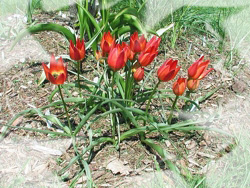 It can be found near cultivated regions, fields, olive groves, meadows, and even in dry places. Its price can be high, at the city, on the blooming season. It can be found near cultivated regions, fields, olive groves, meadows, and even in dry places. Its price can be high, at the city, on the blooming season.
Tulipa undulatifolia. Flowers up to 7 cm long, with orange-scarlet colour. Wavy edged leaves that reach up to 30 cm height. It is rare, and is at risk of extinction. Perhaps it is the same type with the Tulipa Boetica Boiss & Heldr. It grows mainly in cultivated regions, fields, and in fields of mastic trees.
|